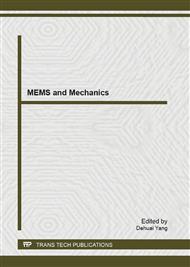[1]
Qiulian Gong ), Zhaoying Zhou, Yihua Yang, Xiaohao Wang,"Design, optimization and simulation on microelectromagnetic pump",Sensors & Actuators A: physical, Vol. 83, pp.200-207, 2000.
DOI: 10.1016/s0924-4247(99)00384-2
Google Scholar
[2]
Kanchan Sharma,Isaac G. Macwan, Linfeng Zhang,Lawrence Hmurcik, Xingguo Xiong,"Design Optimization of MEMS Comb Accelerometer",International conference on electrical and computer engineering,2008.
Google Scholar
[3]
Bing-Chung Chen,Em45lio C. N. Silva,and Noboru Kikuchi,"Advances in computational design and optimization with application to MEMS",International Journal For Numerical Methods In Engineering,2001.
Google Scholar
[4]
Wilfredo Montealegre Rubio,Paulo Henrique de Godoy,and Emílio Carlos Nelli Silva,"Design Of Electrothermomechanical Mems ",ABCM Symposium Series in Mechatronics,Vol.2,pp.469-476,2006.
Google Scholar
[5]
B. M. Adams, M. S. Eldred, and J. W. Wittwer,"Reliability-Based Design Optimization for Shape Design of Compliant Micro-Electro-Mechanical",In Proceedings of 11th AIAA/ISSMO Multidisciplinary Analysis and Optimization Conference,Portsmouth, Virginia,september 2006.
DOI: 10.2514/6.2006-7000
Google Scholar
[6]
Fabio Peano and Tiziana Tambosso,"Design and Optimization of a MEMS Electret-Based Capacitive Energy Scavenger",Journal Of Microelectromechanical Systems, Vol. 14, No. 3, June 2005.
DOI: 10.1109/jmems.2005.844803
Google Scholar
[7]
Ying Zhang, Raffi Kamalian, Alice M. Agogino, and Carlo H. Séquin,"Hierarchical MEMS Synthesis and Optimization ",In Proceedings of SPIE, Vol.. 5763,2005.
Google Scholar
[8]
P. Schneider, E. Huck, S. Reitz, S. Parodat, A. Schneider, P. Schwarz,"A modular approach for simulation-based optimization of MEMS",In SPIE Proceedings of
Design, Modeling, and Simulation in Microelectronics,Vol. 4228,Nov.2000.
DOI: 10.1117/12.405441
Google Scholar
[9]
John K. Sakellaris ,"Finite Element Analysis of Micro Electro Mechanical Systems: Towards the integration of MEMS in design and robust optimal control schemes of smart microstructures",WseasTransactions On Applied And Theoretical Mechanics,Vol.3,April 2008.
Google Scholar
[10]
Aniket Singh, A Amalin Prince, V P Agrawal,"Design Optimization & Comparison of RF Power Sensors based on MEMS ",International Journal of Recent Trends in Engineering, Vol 1, No. 4, May 2009.
Google Scholar
[11]
Sujata N. Naduvinamani, B. G. Sheeparamatti, and Sandeep V. Kalalbandi,"Simulation Of Cantilever Based Rf-Mems Switch Using Coventorware", World Journal of Science and Technology, pp.149-153,2011.
DOI: 10.1109/iecon.2011.6119979
Google Scholar
[12]
Prince Nagpal, Manish Mehta, Kamaljeet Rangra, Ravinder Aggarwal,"Optimization of Capacitive MEMS Pressure Sensor for RF Telemetry ",International Journal of Scientific & Engineering Research, Vol 2, Oct 2011.
Google Scholar


